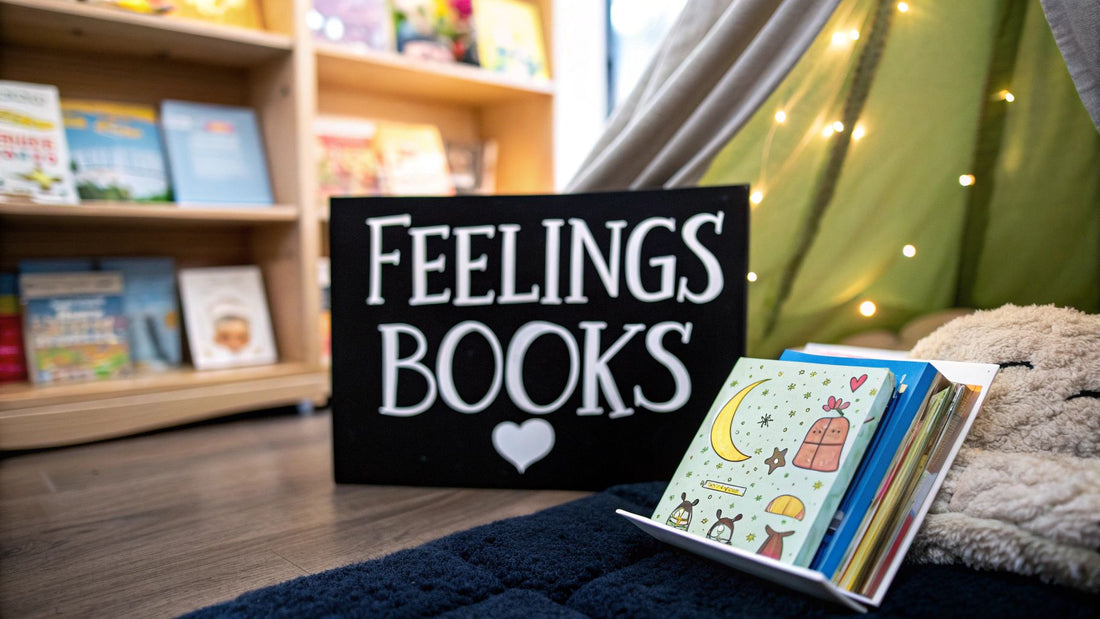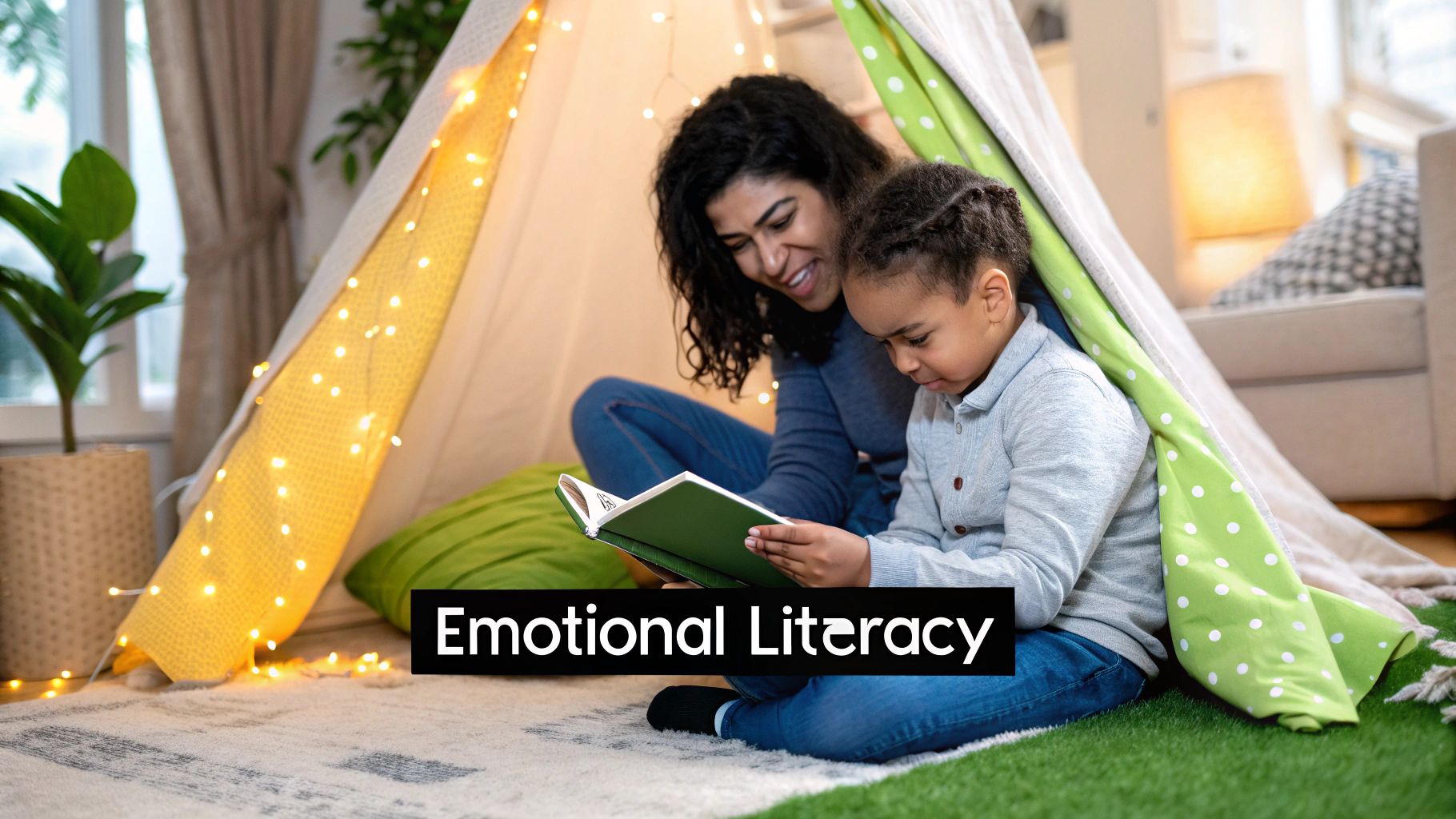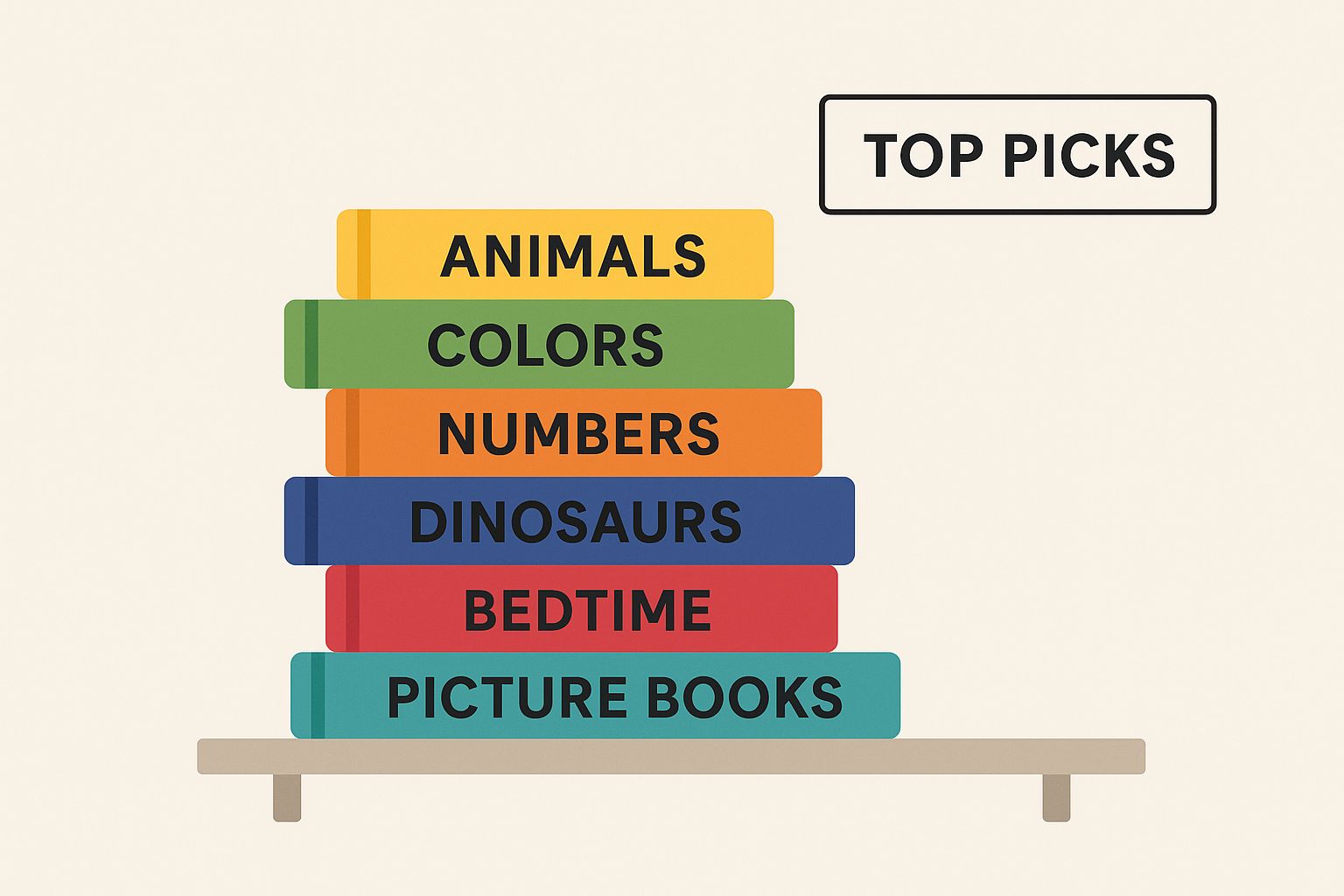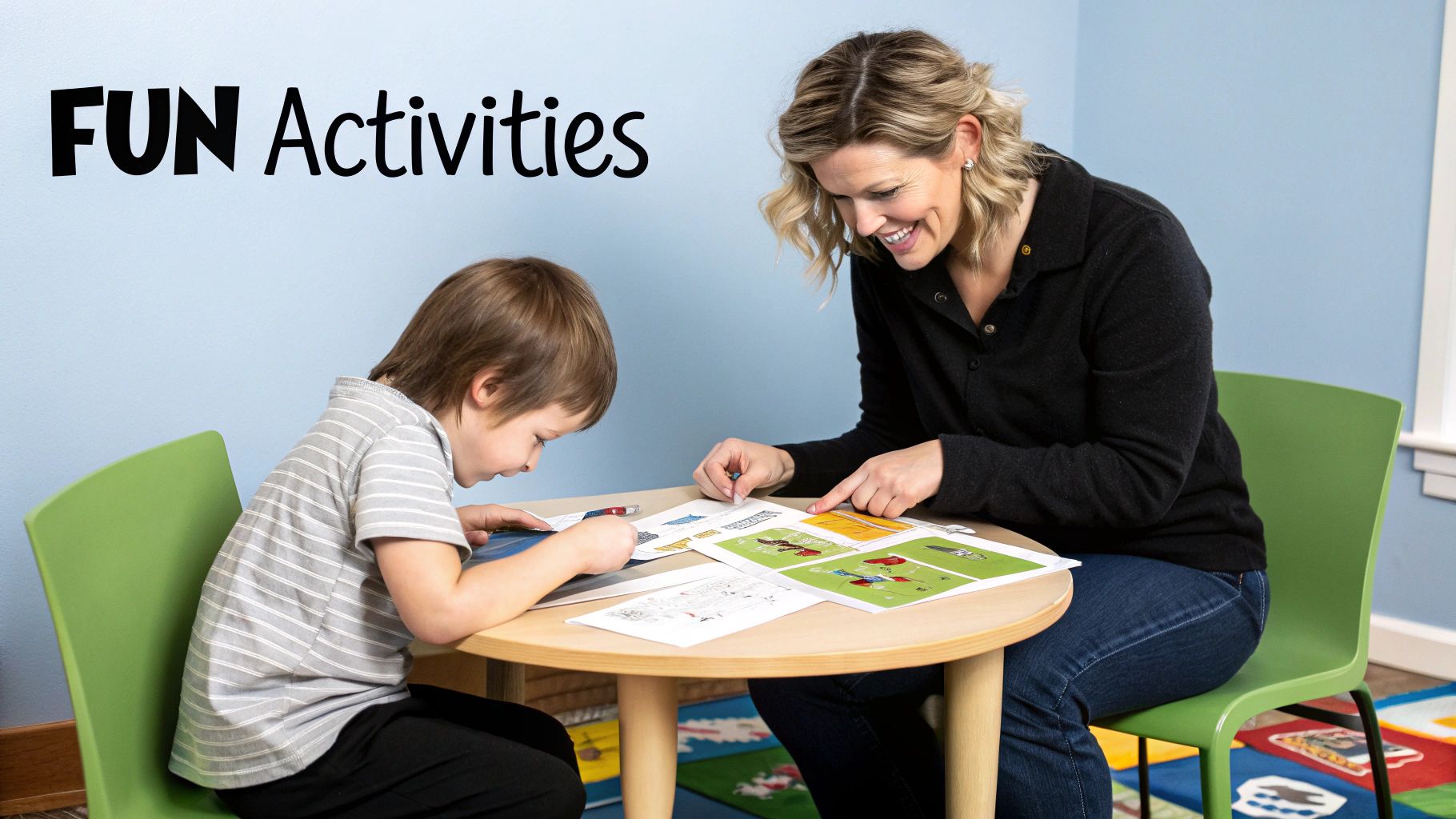
The Best Books About Feelings for Kids
Share
Books about feelings are so much more than just simple stories. Think of them as powerful tools, creating a safe space where children can begin to make sense of big, complicated emotions like sadness, anger, and even overwhelming joy. Through relatable characters and gentle narratives, they give our kids the words they need to talk about what’s going on inside, building a foundation for a lifetime of emotional wellbeing.
Why Talking About Feelings Matters

Starting a conversation about feelings with a child can feel a bit daunting, can’t it? But it’s genuinely one of the most important things we can do for their development. In a world buzzing with pressures from school, friendships, and the ever-present scroll of social media, giving children emotional literacy is no longer a 'nice-to-have'—it's absolutely essential.
The truth is, children's mental health is a growing concern. In 2023, an NHS survey in the UK revealed that one in five children and young people aged 8 to 25 now has a probable mental health condition. This highlights the urgent need to equip our children with emotional tools from an early age. The cost of neglecting mental health is significant, with poor mental health costing UK businesses up to £56 billion annually due to absenteeism and reduced productivity—a cycle that often begins with unaddressed childhood challenges.
The Modern Challenges to Children's Wellbeing
Today’s kids are navigating a world that looks very different from the one we grew up in. The constant connectivity of social media can create unspoken pressures and endless comparisons, making it much harder for them to understand their own worth and manage feelings of anxiety or being left out. It’s this environment that makes it so vital to address mental health proactively, right from a young age.
When children don’t have the words to express what they’re feeling, those emotions can become huge and overwhelming. This can bubble up as behavioural issues, anxiety, or trouble forming healthy, happy relationships. For example, a child who feels constantly anxious about school might complain of a stomach ache to avoid going, because they can't articulate their fear. Building their emotional vocabulary is like handing them a map to navigate their own inner world.
Starting the Conversation With a Story
This is exactly where books about feelings for kids come in. A simple story about a grumpy bear or a lonely lion offers a gentle, indirect way to start exploring those tricky emotions. It creates a shared moment between you and your child, opening the door for simple questions like, "Have you ever felt like that little bear?"
These small conversations are the very building blocks of resilience and empathy. By using stories, you begin to normalise the full spectrum of human emotion, teaching your child that it’s completely okay to feel sad, angry, or scared sometimes. You can learn more about how a children's mental health book can help your child.
Please note: I am not a mental health professional. This guide is for informational purposes. If you have serious concerns about your child’s mental health, it is vital to seek advice from a doctor or a qualified specialist.
How Stories Build Empathy and Social Skills
Think of a picture book about feelings as a kind of ‘emotional flight simulator’ for your child. Tucked up safely in the cosy world of a story, they can explore tricky emotions like jealousy, frustration, or sadness without any real-world consequences. It’s a rehearsal space for life.
When a child sees a character on the page feeling just as they do, it's incredibly powerful. That little rabbit who feels shy at a party, or the small bear who gets angry when their tower of blocks tumbles, shows them they aren't alone. This recognition is a huge first step towards building emotional intelligence.
By following a story from a problem to its solution, children learn about cause and effect in social situations. They see how a character’s actions—like sharing a toy or saying sorry—lead to good things happening. This simple narrative gives them a clear, easy-to-digest blueprint for navigating their own friendships and feelings.
From Story to Real-Life Skills
Talking about a character's choices is where the real magic happens. When you ask simple questions like, "Why do you think the fox felt left out?" or "What could the squirrel have done differently?", you’re not just talking about a book; you're building critical thinking skills. These little chats connect the fictional world directly to their own experiences.
For example, after reading a book about a character who struggles to share, you can gently link it to a real playground moment. You could say, "Remember how the character felt happy when they shared their ball? Maybe we could try that next time at the park." This transforms a simple story into a practical, real-world lesson.
This process is absolutely fundamental for developing empathy. A study involving over 1,200 children found that reading stories together significantly improved their prosocial behaviour. It highlighted just how much a grown-up's guidance during reading can nurture a child’s emotional understanding.
Building an Emotional Vocabulary
Ultimately, these stories give children the words they need—an ‘emotional vocabulary’. Having the right language to describe what’s happening inside them is a complete game-changer. It’s the difference between a toddler having a meltdown out of sheer frustration and a child being able to say, “I feel angry because my brother took my crayon.”
This ability to name and explain feelings is a cornerstone of good mental health and strong social skills. By regularly sharing books about feelings for kids, you give them the tools they need to understand themselves and connect compassionately with others. For a deeper dive, check out our guide on teaching emotional awareness to children.
Choosing the Right Book for Your Child
Walking into a bookshop or scrolling online can feel a bit overwhelming, but finding the perfect books about feelings for kids is much easier when you know what to look for. The real secret is matching the book's message and complexity to your child’s age and whatever they’re going through at the moment. A book that lands perfectly with a seven-year-old might completely miss the mark for a toddler, and the other way around.
For toddlers and preschoolers, the magic words are simplicity and clarity. You'll want to look for books with big, expressive pictures that clearly show emotions like happiness, sadness, or surprise. These books often have very few words because the illustrations do all the heavy lifting, helping little ones put a name to what they're feeling inside. If you need some ideas, our guide to books about feelings for toddlers is a great place to start.
Once they head off to school (around ages 5-8), children are ready for more complex stories. Books for this age group often dive into social situations—things like figuring out friendships, dealing with a bit of jealousy, or understanding loss. The stories create a safe space to talk about these bigger feelings and even come up with some solutions together.
Matching Books to Emotional Needs
Every child is unique, so the "right" book often comes down to the specific emotion they're wrestling with. Is your little one anxious about starting school? Having big, fiery outbursts of anger? Or feeling sad after losing a beloved pet? The good news is, there are wonderful, thoughtfully crafted stories for each of these challenges.
When you're on the hunt, browsing through dedicated children's book categories can be a huge help. It cuts through the noise and helps you find age-appropriate and relevant titles much more quickly. Pinpointing the right theme can transform reading time from a simple activity into a truly supportive and targeted experience.
The picture below highlights some of our favourite picks, all chosen to help open up conversations about different emotions.

Think of it as a quick visual guide to help you find stories that match what's going on in your child's world right now.
Book Selection Guide by Age and Emotional Theme
To make choosing a book even easier, it helps to know what features work best for different developmental stages. The table below is a quick-reference guide to help parents and carers choose the right books about feelings based on their child's age and the specific situation they want to address.
| Age Group | Key Book Features | Example Emotional Themes | Recommended Focus |
|---|---|---|---|
| Toddlers (1-3) | Simple, repetitive text. Bold, clear illustrations of facial expressions. Sturdy board book format. | Happiness, sadness, surprise, basic anger. | Naming and identifying core emotions. |
| Preschool (3-5) | Simple plot with a clear problem and resolution. Relatable characters (animals or children). | Sharing, jealousy, fear of the dark, excitement. | Understanding cause and effect of feelings. |
| Early School Years (5-8) | More complex stories with character development. Introduction to nuanced feelings. | Friendship conflicts, loss, anxiety, empathy, courage. | Developing coping strategies and empathy. |
Ultimately, the goal isn't just to read a story. It's about finding a mirror where your child can see their own feelings reflected and understood. That feeling of being seen is a powerful first step towards building emotional resilience that will last a lifetime.
Turning Story Time Into a Connection Tool
Choosing the perfect book is a great start, but the real magic happens in the moments you share while reading it. Reading a story isn't just about getting through the words on the page; it's a golden opportunity to turn a simple activity into a safe space for bonding and emotional discovery. It’s about moving beyond the narrative and into a meaningful conversation.
Instead of just reading straight through, try pausing at key moments. Gentle, open-ended questions can unlock a world of conversation. These aren't tests with right or wrong answers, but curious invitations to share what they're thinking.
Simple questions make all the difference:
- "How do you think the little rabbit felt when that happened?"
- "That wolf looks very grumpy! Why do you reckon he feels that way?"
- "What do you think might happen next?"
This approach helps children step into a character's shoes, building empathy and understanding from a safe distance.
Making a Story Feel Personal
To deepen the connection, you can link what's happening in the story directly to your child's own world. This helps them see that the characters' feelings are completely normal and that they've probably felt something similar themselves. It makes the abstract idea of an emotion feel tangible and familiar.
For example, if a character feels left out at a party, you could gently ask, "Does that remind you of anything that happened at nursery this week?" This simple bridge between fiction and reality validates their experiences and shows them that you’re there to listen, no judgement attached.
Remember, the goal is to create an opportunity for discussion, not an obligation. If they don't want to talk, that's perfectly okay. The story itself has already planted a valuable seed.
Creating a Calm and Centred Routine
Diving into big feelings can sometimes leave a child feeling a bit stirred up. Pairing story time with a simple relaxation technique can create a wonderfully calming and supportive routine, especially after tackling a tricky emotion like anger or sadness. It’s a gentle way to teach them practical coping skills.
One lovely technique is "teddy bear breathing."
- Ask your child to lie down comfortably and place a favourite soft toy on their tummy.
- Tell them to breathe in slowly and deeply, watching their teddy rise gently into the air.
- Then, ask them to breathe out slowly, watching the teddy float back down.
This simple, playful exercise helps them focus on their breath, calming their nervous system and ending story time on a peaceful, positive note. This turns reading books about feelings for kids into a truly restorative experience.
Navigating Big Feelings Like Anger and Sadness

Some feelings are just… big. For a child, emotions like anger, sadness, or anxiety can feel like a huge, stormy cloud rolling in. It’s overwhelming, it’s confusing, and it often leads to meltdowns or withdrawn behaviour. Why? Because they simply don’t have the tools yet to handle the sheer intensity of what’s happening inside them.
This is where the right books about feelings for kids can be a game-changer. Stories that dive into these tougher emotions show children that what they’re feeling is not only valid but, crucially, manageable. When a character in a book feels that hot surge of anger and learns to take a few deep breaths, it gives your child a real, practical strategy they can remember and use themselves.
These stories essentially provide an ‘emotional vocabulary’. A child who has the words to say, “I feel sad because…” or “I’m worried about…” is far less likely to express that feeling by hitting, shouting, or shutting down completely. It’s a powerful shift from acting out an emotion to actually articulating it.
Practical Coping Strategies in Stories
Think of these books as gentle instruction manuals for managing emotions. They model healthy ways to process difficult feelings in a format that children can easily grasp and imitate.
A story might feature, for instance:
- A little monster who draws their "anger creature" on paper to let the feeling out.
- A small bear who feels anxious about starting school and finds relief by talking to a parent about their worries.
- A fox cub who feels desperately sad after losing a favourite toy and finds comfort in a big hug.
These simple, actionable scenes give children a toolkit of strategies they can pull from in their own lives. This kind of modelling is vital for developing emotional intelligence. In fact, research shows a direct link between a child's understanding of emotions and the quality of their social interactions. When children, especially girls, have lower emotional intelligence, it can sometimes be linked to more aggressive behaviours. You can read the full research about these findings here.
A key message these books reinforce is that no feeling is "bad." It is completely okay to feel angry, sad, or frightened. The story helps to separate the feeling itself from the behaviour that follows, empowering children to make positive choices even when they are struggling with a big emotion.
Normalising the Full Spectrum of Emotions
Ultimately, sharing these kinds of stories helps to normalise the entire messy, wonderful range of human feelings. When you explore sadness and anger with the same gentle curiosity as you do happiness and excitement, you send a powerful message: all of your feelings are welcome here.
This acceptance is the bedrock of good mental health. It builds a child’s self-awareness and self-compassion, giving them the confidence to face life’s challenges. It shows them that even the stormiest emotional clouds will eventually pass, and that they have the strength—and the tools—to wait for the sun to come out again.
Common Questions from Parents
It’s completely normal to have questions when you first start using books about feelings for kids. This isn't about getting it perfect; it's about opening up a new way to connect with your child. To help you feel more confident, we've gathered some of the most common queries we hear from parents.
What if My Child Doesn't Want to Talk?
First, don't panic. You can't force a conversation about feelings, and that’s okay. If your child clams up or seems quiet after a story, the book has still done its job. It's planted a seed.
Sometimes, a child just needs a bit of space to let the story sink in. They might bring it up out of the blue later—in the car, during bathtime, or just before bed. The goal is to create a safe space for discussion, not to make it a requirement. If you’re looking for a gentle way in, try asking something simple like, "What was your favourite part?" It can be a surprisingly effective way to open the door to a bigger chat.
The key is to create an opportunity for discussion, not a requirement. A child might need time to process, and that's a crucial part of their emotional journey.
How Often Should We Read These Books?
There's no magic number here. The best approach is simply to weave these books into your normal reading routine. Not every storytime needs to be a deep dive into emotions. The idea is to normalise talking about feelings, making it a natural part of everyday life rather than a big, serious topic.
A good balance might be to mix one or two emotion-focused books into your reading list each week, alongside all the other fun, silly, and adventurous stories you both love. Of course, during big life changes—like starting school or welcoming a new sibling—you might find yourselves reaching for them a bit more often for that extra layer of support.
At What Age Should I Start?
You can start much earlier than you might think. For babies and toddlers, simple board books that just show different facial expressions—happy, sad, surprised—are brilliant. They help build the very first foundations of emotional literacy by connecting a word to a feeling.
As they move into the preschool years (around ages 2-5), you can introduce stories with simple plots that explore ideas like sharing, feeling shy, or getting excited. The sooner you start, the more these conversations will feel like a comfortable, normal part of your family's dynamic. Just make sure the complexity of the book matches where your child is at developmentally.
Are There Other Resources Besides Books?
Absolutely! Books are a fantastic starting point, but they’re even more powerful when they're part of a bigger toolkit for emotional learning. There are loads of creative ways to keep the conversation going.
Here are a few ideas:
- Feelings Flashcards: Use cards with different emotions drawn on them to play fun guessing games.
- Mental Health Books: Beyond picture books, there are many fantastic reads for older children and parents that delve deeper into wellbeing.
- Mental Health Apparel: Sometimes a t-shirt or jumper with a positive message can be a simple, visual reminder to be kind to our minds.
For more perspectives and practical advice on child development and emotions, the BuddyPro blog for parenting insights is a great place to find valuable resources. The main goal is to build an environment where feelings can be talked about openly and without judgement.
Please remember, I am not a mental health professional. If you have serious concerns about your child's wellbeing, it is always best to seek advice from a doctor or a qualified specialist.
At Little Fish Books, we believe every story is a chance to connect and grow. Our curated collection of books and resources is designed to help you and your child navigate the world of feelings together. Explore our supportive tools and start building emotional resilience today at https://thatsokay.co.uk.
